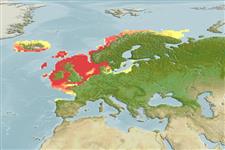Environment: milieu / climate zone / depth range / distribution range
Ecologia
marinhas demersal; oceanódromo (Ref. 51243); intervalo de profundidade 10 - 200 m, usually 10 - 150 m (Ref. 35388). Temperate; 72°N - 43°N, 26°W - 45°E (Ref. 54592)
Northeast Atlantic: Bay of Biscay to the White Sea and off Iceland.
Length at first maturity / Tamanho / Peso / Idade
Maturity: Lm 29.3, range 20 - 30 cm
Max length : 65.0 cm TL macho/indeterminado; (Ref. 9988); peso máx. Publicado: 3.0 kg (Ref. 6112); Idade máx. registada: 23 anos (Ref. 6112)
Small head and mouth. Body is oval. Skin is marbled and smooth. Lateral line almost straight, slight curve above the pectoral fin (Ref. 35388).
Lives most often on stony bottoms. Feeds on a variety of small invertebrates, but polychaetes seem to dominate. Apparently they do not feed in wintertime (Ref. 9900). Marketed fresh and frozen; eaten steamed, fried, broiled, microwaved and baked (Ref. 9988).
Spawning is mainly confined to depths of 55-91 m in the northwestern North Sea and commences at a minimum temperature of 6.5 °C in Scottish waters. Sex ratio is about 1:1, but females progressively predominate upon sexual maturity.
Vinnikov, K.A., R.C. Thomson and T.A. Munroe, 2018. Revised classification of the righteye flounders (Teleostei: Pleuronectidae) based on multilocus phylogeny with complete taxon sampling. Molecular phylogenetics and evolution, 125:147-162. (Ref. 122998)
Categoria na Lista Vermelha da IUCN (Ref. 130435: Version 2024-2)
Ameaça para o homem
Harmless
Utilização humana
Pescarias: espécies comerciais; peixe desportivo: sim; Aquário: Aquários públicos
Ferramentas
Relatórios especiais
Descarregue XML
Fontes da internet
Estimates based on models
Preferred temperature (Ref.
123201): 7.1 - 12.5, mean 9.9 °C (based on 1310 cells).
Phylogenetic diversity index (Ref.
82804): PD
50 = 0.5625 [Uniqueness, from 0.5 = low to 2.0 = high].
Bayesian length-weight: a=0.00741 (0.00591 - 0.00930), b=3.09 (3.02 - 3.16), in cm total length, based on LWR estimates for this species (Ref.
93245).
Nível Trófico (Ref.
69278): 3.2 ±0.33 se; based on food items.
Resiliência (Ref.
120179): Médio, tempo mínimo de duplicação da população 1,4 - 4,4 anos (K=0.08-0.42; tm=3-6; tmax=23).
Prior r = 0.71, 95% CL = 0.47 - 1.07, Based on 1 full stock assessment.
Fishing Vulnerability (Ref.
59153): Moderate to high vulnerability (51 of 100).
Climate Vulnerability (Ref.
125649): Low to moderate vulnerability (29 of 100).
Nutrients (Ref.
124155): Calcium = 20.4 [11.3, 39.5] mg/100g; Iron = 0.237 [0.134, 0.434] mg/100g; Protein = 17 [15, 19] %; Omega3 = 0.301 [0.150, 0.610] g/100g; Selenium = 18.1 [9.7, 37.5] μg/100g; VitaminA = 7.6 [1.8, 30.7] μg/100g; Zinc = 0.377 [0.264, 0.576] mg/100g (wet weight);
